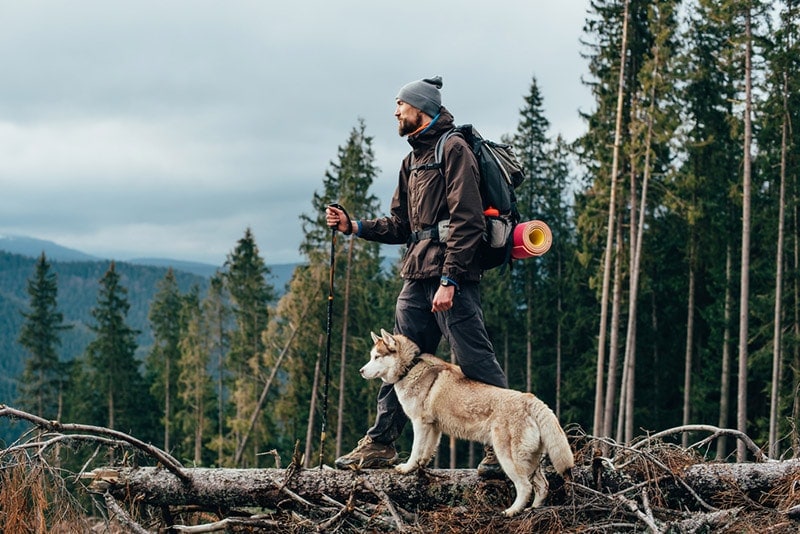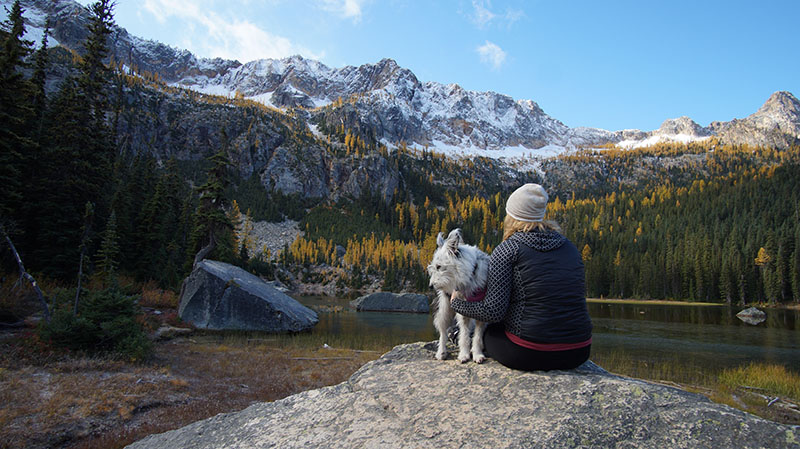We have 154 national forests covering over 190 million square miles in the U.S., plenty of space for several lifetimes worth of exploration. But when you have a dog equally up for an adventure, what are the chances you can bring them along? Luckily, your pup won’t limit your opportunities. Dogs can come along for the hike in all national forests if you follow the leash laws.
Staying safe and responsible with dogs in national forests isn’t always straightforward. Failing to heed crucial guidelines and best practices could put you and your dog at risk of injury or a National Forest Service violation. We’ll discuss the ins and outs of taking your dogs to a national forest to ensure you both enjoy a positive experience.

Are Dogs Allowed in National Forests?
Dogs are allowed in all national forests, but you must abide by leash laws and never leave your dog unattended.
- Developed recreation areas, such as picnic sites and campgrounds
- Parking lots
- Interpretive trails (trails with signs and exhibits telling the story of the area and offering unique facts)
The laws are often stricter than campers and hikers realize. For instance, swimming in a body of water may require a leash if it connects to a developed recreation area. Beyond those areas with national leash regulations, the county sets rules regarding how you can control your pets. Researching the rules surrounding dogs on hiking trails and other non-developed spots in the forest you plan to visit is crucial to ensure you stay compliant.

Top 5 Tips for Staying Safe with Dogs in National Forests
Entering a national forest with your dog demands that you give respect in several directions. The area has rules and rangers to enforce them, other people using the campground and hiking the trails, and various hazards that could endanger your pet. Following a few basic guidelines will help you avoid fines, confrontations with fellow campers, and the risk of your dog getting injured or lost.
1. Maintain Control of Your Dog
Look up the national forest you intend to visit online for information about how to manage your dog and where they can go. You can find information about each national forest by state on the Forest Service website. Learn about the leash and confinement rules for campgrounds, trails, and any other area you plan to visit.
Maintaining constant control of your dog by leash or voice command is crucial no matter where you are in a national forest. While a leash may not be required in certain forest areas, you must keep your dog leashed if you are not confident they will respond to you.
2. Update Dog IDs
Losing a dog in the woods can be a scary ordeal, but you can rest easier in even the vastest national forest when you give yourself a better chance of finding them. Before hitting the woods, check your dog’s microchip information to ensure it’s updated. Ensure your dog has appropriate IDs with your contact info on their tags, and consider investing in a GPS collar.

3. Protect Your Dog from Animals
Wild animal interactions are unlikely during the day, but camping at night could put your pet at risk if they wander off. Always keep your dog in your tent or camper at night. Feed them away from the tent, clean up any leftover food before retiring, and store dog food in bear-resistant canisters at least 100 feet from the campsite.
4. Respect Those Around You
Stay aware of others around you and their sensitivities to dogs. Other pets or small children may become uneasy or agitated around your dog, so keeping a leash on hand at all times to use as the situation calls for it will ensure everyone stays comfortable.

5. Clean Up After Your Dog
Dog waste is unsightly and unsanitary, creating unnecessary risks for other hikers, their pets, and wildlife. Always clean up after your dog, and drop bags in the nearest trash receptacle or take it with you to dispose of at home.
6. Know Your Dog’s Limits
Compare your plans with your dog’s capabilities. You don’t want to plan a hike that is several miles long if your dog isn’t used to that kind of exertion. Consider your dog’s age and health, and seek advice from your vet before heading to the forest. Keep plenty of extra water available, and take frequent breaks to monitor your dog and give them a chance to rest.

 What Is the Difference Between a National Park and a National Forest?
What Is the Difference Between a National Park and a National Forest?
National parks and national forests can be easy to confuse, yet the difference can be significant if you want to bring your dog. The National Park Service and Fish and Wildlife Service are focused solely on conservation in their areas, while national forests allow for more diverse land use. They’re generally more tolerant of pets as well.
National parks often limit dogs to developed recreation areas, but some are more pet-friendly than others. The National Park Service offers this handy guide for planning a visit to a park with your pet. In many parks, you and your dog can participate in Bark Ranger programs to learn the rules and principles of navigating the area with your pet and promoting proper stewardship.
Always check whether you are in a national park or national forest. The distinction affects where you can explore with your pets and how authorities will respond to violations and animals at large.
For instance, if you lose your dog in a national forest and an officer captures them, you have five days after notification to get your dog. By contrast, national park rangers only give you 72 hours to follow up after they contact you, which is a minor difference that could have major implications for your pet.


Final Thoughts
Dogs are allowed in national forests, but each area has nuances to consider before you can plan an outing with your pet. More importantly, not all dogs are physically or behaviorally fit for the campground or the trail. Be honest about your dog’s temperament around others and their ability to handle time in the woods, and you’ll be well-prepared to have an incredible outdoor experience with your best friend.
Related Reads:
Featured Image Credit: Peter Mayer 67, Shutterstock



















